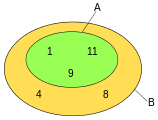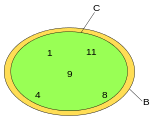Subset
In mathematics, a set A is a subset of a set B if all elements of A are also elements of B; B is then a superset of A.
It is possible for A and B to be equal; if they are unequal, then A is a proper subset of B. The relationship of one set being a subset of another is called inclusion (or sometimes containment). A is a subset of B may also be expressed as B includes (or contains) A or A is included (or contained) in B. A k-subset is a subset with k elements.

A is a subset of B (denoted ) and, conversely, B is a superset of A (denoted ).
The subset relation defines a partial order on sets. In fact, the subsets of a given set form a Boolean algebra under the subset relation, in which the join and meet are given by intersection and union, and the subset relation itself is the Boolean inclusion relation.
Definition
If A and B are sets and every element of A is also an element of B, then:
- A is a subset of B, denoted by
, or equivalently,
- B is a superset of A, denoted by
- A is a subset of B, denoted by
If A is a subset of B, but A is not equal to B (i.e. there exists at least one element of B which is not an element of A), then:
- A is a proper (or strict) subset of B, denoted by
, or equivalently,
- B is a proper (or strict) superset of A, denoted by
- A is a proper (or strict) subset of B, denoted by
The empty set, written 






When quantified, 

We can prove the statement 
Let sets A and B be given. To prove that

- suppose that a is a particular but arbitrarily chosen element of A
- show that a is an element of B.
The validity of this technique can be seen as a consequence of universal generalization: the technique shows 


The set of all subsets of 








Properties
- A set A is a subset of B if and only if their intersection is equal to A.
- Formally:
- A set A is a subset of B if and only if their union is equal to B.
- Formally:
- A finite set A is a subset of B, if and only if the cardinality of their intersection is equal to the cardinality of A.
- Formally:
⊂ and ⊃ symbols
Some authors use the symbols 




Other authors prefer to use the symbols 












Examples of subsets

- The set A = {1, 2} is a proper subset of B = {1, 2, 3}, thus both expressions
and
are true.
- The set D = {1, 2, 3} is a subset (but not a proper subset) of E = {1, 2, 3}, thus
is true, and
is not true (false).
- Any set is a subset of itself, but not a proper subset. (
is true, and
is false for any set X.)
- The set {x: x is a prime number greater than 10} is a proper subset of {x: x is an odd number greater than 10}
- The set of natural numbers is a proper subset of the set of rational numbers; likewise, the set of points in a line segment is a proper subset of the set of points in a line. These are two examples in which both the subset and the whole set are infinite, and the subset has the same cardinality (the concept that corresponds to size, that is, the number of elements, of a finite set) as the whole; such cases can run counter to one's initial intuition.
- The set of rational numbers is a proper subset of the set of real numbers. In this example, both sets are infinite, but the latter set has a larger cardinality (or power) than the former set.
Another example in an Euler diagram:
- A is a proper subset of B.
- C is a subset but not a proper subset of B.
Other properties of inclusion

 and
and  implies
implies 
Inclusion is the canonical partial order, in the sense that every partially ordered set 



For the power set 








See also
- Convex subset – In geometry, set whose intersection with every line is a single line segment
- Inclusion order – Partial order that arises as the subset-inclusion relation on some collection of objects
- Region – Connected open subset of a topological space
- Subset sum problem – Decision problem in computer science
- Subsumptive containment – System of elements that are subordinated to each other
- Total subset – Subset T of a topological vector space X where the linear span of T is a dense subset of X
- Mereology – Study of parts and the wholes they form
References
Bibliography
- Jech, Thomas (2002). Set Theory. Springer-Verlag. ISBN 3-540-44085-2.
External links
 Media related to Subsets at Wiki Commons
Media related to Subsets at Wiki Commons- Weisstein, Eric W. "Subset". MathWorld.
This article uses material from the Wikipedia English article Subset, which is released under the Creative Commons Attribution-ShareAlike 3.0 license ("CC BY-SA 3.0"); additional terms may apply (view authors). Content is available under CC BY-SA 4.0 unless otherwise noted. Images, videos and audio are available under their respective licenses.
®Wikipedia is a registered trademark of the Wiki Foundation, Inc. Wiki English (DUHOCTRUNGQUOC.VN) is an independent company and has no affiliation with Wiki Foundation.








